Instruction for use: Tropicamide (Tropicamidum)
I want this, give me price
chemical name
N-Ethyl-α- (hydroxymethyl) -N- (4-piperidinylmethyl) benzene acetamide
Pharmacological group
M Cholinolytics
Ophthalmic agents
The nosological classification (ICD-10)
H02.5 Other diseases that disrupt the function of the eyelid
Spikes of the eye, The twist and turn of the century
H10.9 Conjunctivitis, unspecified
Trahomny conjunctivitis, catarrhal conjunctivitis, Giperpapillyarny conjunctivitis, Non-infectious conjunctivitis, purulent conjunctivitis, Purulent conjunctivitis form, Year-round conjunctivitis, purulent conjunctivitis, Subacute conjunctivitis, Secondarily infected with conjunctivitis
H44.8 Other diseases of the eyeball
Hemophthalmus, Spikes of the eye
H57.8 Other unspecified disorders of the eye and adnexa
Intraocular hemorrhage, Inflammatory eye disease, Secondary bloodshot eyes, Burning sensation in the eyes, Protecting the front surface of the eye, Itchy eyes, Xerosis, Itching and burning eyes, Dry eye syndrome, Dry eye, xerophthalmia
H599 * Diagnosis / eye disease diagnostics
Angioscopy iris, Gonioscopy, Diagnosis in Ophthalmology, Differential diagnosis of the type of injection of the eyeball, A study of the fundus, A study of the fundus and lens, Control of the rear segment of the eye state, mydriasis, Examination of the retina during surgery, Examination of the retina after surgery, Definition of manifest refraction, Determination of refraction, Determination of refraction using skiascopy, Ophthalmic diagnostics, funduscopy, pupil dilation, Creation of mydriasis, Creating cycloplegic, Fluorescein angiography of retinal vessels, electroretinography
Code CAS
1508-75-4
Pharmacology
Pharmacological action - mydriatic.
It blocks m-holinoretseptory sphincter of the iris and ciliary muscle. Expands the pupil, causes paralysis of accommodation. The action is fast and short. Dilation of pupils and cycloplegia begin in 5-10 minutes, reach a maximum in 30-45 minutes and last for 1-2 hours. The initial width of pupils is restored in 6 hours.
Additional information on the carcinogenicity and mutagenicity of Tropicamide
There were no long-term studies to study the carcinogenic activity of tropicamide in animals. There is insufficient data to estimate the effect of tropicamide on the reproductive capacity of animals in vivo.
Additional information on the effect on the fertility of Tropicamide
There is no data on the potential ability of tropicamide to affect the fertility of men and women. Information on the possible teratogenic effects and other adverse effects of tropicamide on the fetus is absent.
Application of the Tropicamide
Diagnosis in ophthalmology (the necessity of mydriasis and cycloplegia is the examination of the fundus, the definition of refraction with the help of a skiascopy). Inflammatory processes and eye adhesions.
Contraindications
Hypersensitivity, glaucoma (especially the closed-angle form).
Additional information on contraindications to the use of tropicamide
Contraindicated in the use of tropicamide in primary glaucoma, as well as in the presence of factors predisposing to the development of glaucoma (for example, a narrow angle of the anterior chamber), with the known intolerance of any components of preparations of the tropicamide.
Restrictions on the use
Pregnancy, lactation, infancy.
pregnancy and lactation
Application in pregnancy tropicides
FDA exposure category - C.
There have been no studies to study the effect of tropicamide on reproductive ability in animals. It is also not known whether tropicamide can adversely affect the development and growth of the fetus and the reproductive capacity of women, if used in pregnancy. The appointment of tropicamide during pregnancy is possible only in case of emergency.
breast-feeding
There is no data on the possibility of excretion of tropicamide with human breast milk. Considering the fact that many drugs are excreted in human breast milk, care must be taken when prescribing tropicamide during lactation.
Side effects
Ophthalmic reactions: transient burning, blurred vision, superficial pinpoint keratitis, paresis of accommodation, photophobia, increased intraocular pressure, glaucoma attack, allergic reactions.
Systemic: dry skin and mucous membranes, incl. Dry mouth, nausea, vomiting, tachycardia, pallor, excitement, headache, convulsions, coma, respiratory paralysis.
With the use of anticholinergic drugs in children, the development of psychotic reactions, behavioral disorders, vasomotor or cardiorespiratory collapse was reported.
Interaction
The effect is enhanced by sympathomimetics, weaken m-cholinomimetics. The likelihood of developing systemic side effects increases tricyclic antidepressants, phenothiazines, amantadine, quinidine, antihistamines and other agents with m-cholinolytic properties.
Routes of administration
Conjunctival.
Precautions for Tropicamide
Eye drops should be instilled in the lower conjunctival sac. To reduce the resorption is recommended to lightly apply pressure on the area of lacrimal sacs 2-3 minutes after instillation. During the treatment period, you can not wear soft contact lenses.
Additional information on precautionary measures for the administration of tropicamide
Caution should be used to administer cycloplegics and mydriatic medications, including tropicamide, to elderly people and other patients at risk of increased intraocular pressure. To avoid provoking the development of an attack of angle-closure glaucoma, the depth of the anterior chamber angle should be assessed before the administration of these preparations. It is necessary to press a finger a tear sack for two to three minutes after the instillation of the drug to reduce the amount of absorption of the drug and minimize the systemic effects of tropicamide.

 Cart
Cart





